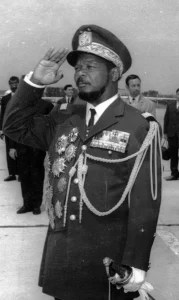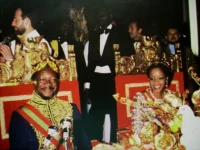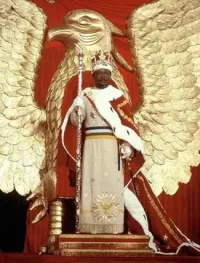
Jean Bédel Bokassa ruled as President-for-life and later as Emperor of the Central African Republic from 1966 to 1979. In his youth he served in the French Colonial Army earning the rank of captain fighting in what would become Vietnam. Bokassa’s erratic and sometimes brutal regime began after he seized power in a military coup, and his actions increasingly isolated him from the international community. Ultimately he would be deposed by the French and forced into exile, though not before Bokassa had declared himself to be an emperor.
On December 4, 1976, Bokassa crowned himself in extravagant fashion, sparing no expense as he sought to create a Napoleonic empire in the heart of Africa. Anthony Quainton, the U.S. Ambassador to the CAR at the time of the coronation, describes the lavish decadence of the event which was financed by none other than the French government — an amount roughly equal to one year’s budget for the entire country. Bokassa was later the subject of a documentary by famed director Werner Herzog.
You can read about Nelson Mandela, the Ivory Coast’s Felix Houphouët-Boigny, Togo’s Eyadema, and other Moments on Africa.
“Bokassa announced that he had traced his ancestry back to the pharaohs”

QUAINTON: In early 1978, Bokassa decided that his status as a seven-star field marshal and President-for-life did not give him sufficient recognition in the world of post-colonial Africa, so he proposed to make himself emperor. The first indication we had of that was when his wife gave birth early in 1978 to a little girl, her name was Anne, and it was announced in the local press that she was the Princess Anne. This implied royal paternity. There were many rumors about the empire, what kind it might be.
It was assumed early on in 1978 that Bokassa would try to model any empire on one of the great medieval empires in Africa, picking on the great tradition of chiefly rule, but dressing it up in a more modern kind of royal framework. In fact, he decided what he wanted to be was not the successor to any chief in Africa, but a successor to the pharaohs and to Napoleon. So the style of the empire was Napoleonic, the pedigree of the empire was pharaonic. Bokassa announced that he had traced his ancestry back to the pharaohs.
When the empire was actually established, it did not look at all Egyptian. Rather, it was a black version of Napoleon’s empire. That, of course, was a very expensive proposition. The French were very reluctant to back it. They disapproved of Bokassa’s Napoleonic ambitions, but did not insist that he be an African-style king. They ultimately agreed to pay the full costs of his imperial coronation — costs that ran, according to some accounts, to something on the order of $45 to 50 million….
They [the French] had no alternative to Bokassa. Bokassa had a claim to French nationality by virtue of his service in the French army. He had been a loyal friend of France on all African issues. He was a great admirer, publicly and otherwise, of Charles de Gaulle. He was a regular hunting partner of the President of France, Giscard d’Estaing, who came annually to the Central African Republic to hunt elephants with Bokassa in the eastern portion of the country.
It also testifies a good bit to the personal qualities of Bokassa, which have not been much commented on by history. He and the highly intellectual President of France could spend two weeks on safari in the countryside together sharing war stories, reminiscences and discussing the affairs of the world in a way that was entirely satisfactory to the President of France, who later received a famous necklace of diamonds as a gift from Bokassa, which eventually created a great scandal in France.
So there were many ties: Bokassa was a loyal friend of France, a loyal member of the French army; he had a chateau in Sologne in the central part of France; and the French felt a certain loyalty to him notwithstanding his quite extraordinary idiosyncrasies. Not that they approved of everything he did, but they saw no reasonable alternative to him at that time, although in 1979 they brought about his overthrow by the introduction of French paratroopers. But this was only after another bizarre set of incidents involving the shooting of high school students in the center of Bangui at Bokassa’s personal direction….
Clearly Bokassa’s decision was thought in Washington to be the most extraordinary piece of foolishness. On the other hand, Washington was very cautious, since we had limited but real interests in terms of Bokassa’s support for us at the United Nations and our limited economic assets in the country. The embassy tried not to make fun of Bokassa in the messages and cables that we sent in. I must say I consciously tried to describe events with as straight a face as possible. It was easy to make cheap and rather amusing comments about this kind of exotic regime, but the end result might have been to put individual Americans, missionaries and business people, in peril.

We tried to avoid too many quotable quotes, although I think there were times when we did allow ourselves to describe with a certain tongue-in-cheek quality the political evolution of the Central African state.
The republic took some months to die or the empire some months to be born, during which Bokassa began the preparations for the coronation. He invited the Pope to crown him, as the Pope had been invited to crown Napoleon. He developed a new court protocol for the empire. He consulted a number of ambassadors on the subject, not including the American ambassador, as we weren’t thought to have any particular wisdom about imperial practices. He consulted the Greek ambassador resident in Yaoundé on the court procedures at the court of Constantine Palaeologus, someone whom he felt might be an appropriate model for his own empire.
Q: Constantine Palaeologus was the last of the Byzantine emperors.
QUAINTON: That’s right, in the 15th century. The Greek republican government had some difficulty coming up with anything that was useful for the new empire. Court protocol was, however, developed and we were sent appropriate instructions in a diplomatic note on how to comport ourselves in the presence of His Imperial Majesty, including instructions as to how far we should stand from him, what kind of bow we should make, how we should answer questions from the imperial personage (the answer to any question, we were instructed, was always to be “Yes,” but if that left something to be desired, you were permitted to say, “Yes, but.”).
It was announced, although never enforced, that all those who went into the presence of His Imperial Majesty would retreat backwards. Bokassa took all this as a great joke himself. I think he had great fun writing it all up and sending instructions around to bemused governments as to how they should behave in his presence.
A Millard Fillmore Plate for the Emperor
There was a great question as to how the United Stated should be represented at the coronation. Bokassa invited the President, as he invited the Pope and the president of France, and there was a certain amount of exchanging of views among the diplomatic corps about the level at which we were going to be represented at this solemn occasion. At the end of the day, the French decided to send a minister, Mr. Gallet, who was then the Minister of Cooperation, the French aid minister, and his wife. Most other governments were represented by their resident ambassadors, although there were some ministerial delegations from other African states. If I am not mistaken, President Mobutu came up from Zaire to be present at the coronation.
Having decided on the level of delegation, there was then the problem of the ceremonial gift that one was expected to give on the occasion of his coronation. This posed some considerable problems for us. The Office of Protocol had only a limited supply of gifts for coronations and they were generally not suitable. I had started my tour in Central Africa with a gift for the then president. His birthday was the same day as George Washington’s and as it was the beginning of the bicentennial year, 1976, when I arrived.
I had brought with me a rather beautiful Limoges bowl inscribed with the arms of George Washington and the bicentennial years — 1776-1976. I took it on my inaugural call, which took place only two days before Bokassa’s birthday and I thought, tongue in cheek, it was appropriate to give him a token of my esteem. He looked at the bowl bemusedly and said how beautiful it was, looked at the dates, 1776-1976, and said, “Ah, what a long life George Washington had.” But, he noted, they were both generals and founders of their countries.

With that as background, the office of protocol came up with two plates from the Franklin Mint. Sometime in the 1970s, the Franklin Mint had produced a series of very elegant silver plates engraved in gold with portraits of the presidents of the United States.
Some of them were long since gone — John F. Kennedy, George Washington, Abraham Lincoln, etc. — but Chester Arthur and Millard Fillmore were still in stock, and I received two plates to give to the emperor on the occasion of his coronation. He kept me waiting for some hours to present our official gift because I was way down in the protocol list of coronation delegations. Ministers got in first.
But eventually he got to me. He expressed enormous pleasure, real or feigned, and said that the plates would have a prominent place in the imperial state museum when it was created. Alas, it was never created, and the plates have long since disappeared. The coronation was indeed a splendid event. It took place at a sports palace built by the Yugoslav government some years before as part of their aid program. It was a rather handsome basketball stadium seating several thousand people. There was a great golden throne in the shape of an imperial eagle.
Bokassa, himself, wore a Roman toga embroidered with a hundred thousand pearls. He came wearing a gold laurel wreath in his hair, and an imperial toga and staff. As in the case of Napoleon, he crowned himself in the presence of his family, visiting delegations and selected guests. He then drove in a coach pulled by the six white horses, which had been flown from Paris to draw the new gold coach from the sports palace to the cathedral.
Coronation in a Catholic Cathedral for a Muslim Emperor

The cathedral was a rather charming brick church built before the Second World War. Bokassa’s first cousin was the archbishop of Bangui and in a solemn mass the coronation was graced by Cardinal Silvestrini, who had been sent to represent the Holy Father on this grand occasion. The cathedral had been decorated, I exaggerate not, from floor to ceiling with cut flowers flown in from France. This was a very lofty church and there must have been tens of thousands of flowers which covered the walls.
Cardinal Silvestrini sat on his throne to the left facing the altar and Bokassa sat on his throne to the right. He, of course, wore an ermine cape of Napoleonic proportions decorated with “B’s” for Bokassa. It was all rather splendid. The irony of it all was that Bokassa was no longer a Catholic, but had become a Muslim some months before, during the republic, when he was visited by Muammar Qaddafi….
Qaddafi did a number of things during the official visit. There was a marvelous state dinner at which Bokassa organized a local dance troop of bare-breasted maidens dancing erotic African dances. Qaddafi was not much amused, but Bokassa thought that it was an appropriate tribute for a visiting head of state, to give them some of the local culture. But it was not the austere Islamic kind of culture to which Qaddafi was used to on visits. He met with the diplomatic corps.
I am one of the few American diplomats in recent times who have actually met Qaddafi. I talked to him over tea with five or six colleagues. He speaks some English and was rather gracious, not particularly fanatical in his personal address. The day after the state dinner, he spoke to the assembled members of MESAN, the principal and only party in the Central African Republic, at the same sports stadium in which Bokassa was later to be crowned emperor. He gave a several hours long exhortation about the virtues of Islam, asserting that Islam was the religion of the oppressed, the religion of the black man, while Christianity was the religion of the oppressor and the white man….
In any case, by the time of the coronation, Bokassa was still a Muslim and the Church had excommunicated him. So, it was all the more remarkable that Cardinal Silvestrini was there. The Roman Catholic priests of the empire, almost all of whom were European, solemnly protested to the Vatican the extraordinary decision to send Silvestrini to the coronation. They regarded this as a sacrilege and refused to participate in the coronation ceremonies
The other highlight of the coronation was the choir. There was a choir of children who had been trained for some months to sing Mozart’s Coronation Mass, unfamiliar to most of the children of Central Africa, the irony being that the coronation concerned is the coronation of the Virgin, not of some lay figure of note. There was a spectacular party which ended with a state dinner. In front of every guest was a bottle of vintage Dom Perignon champagne. There were many courses elegantly served, fireworks followed and the empire was launched at the expense of the French taxpayer in a rather grand way….
“The French were furious”

I was the representative [for the United States]. The Central African desk officer came out to join the delegation. I neglected to mention that not only were we instructed on protocol, but also on the dress. Men were expected to be in full court attire, top hat, morning coat, and striped trousers, the only problem for me being that I had rented my morning coat in Paris which was designed for a cooler climate and was of a rather thick flannel. In the 100 degree temperature of Central Africa, it was oppressive.
The ladies had all been instructed on what to wear by the empress, who invited the ambassadors’ wives to a tea party to explain how they should be dressed. Long pastel dresses were favored by the empress along with broad, brimmed hats.
So all of the wives came appropriately attired. Unfortunately, when the French minister’s wife came with her husband at the end of the ceremony to present the French official gift, the court protocol officer decided that her dress was not sufficiently long and she was sent away. Although the French were paying for the event, the French minister was told that he could not come until his wife was correctly attired for the imperial presence. The French were furious, but Madame Gallet changed. I was kept waiting to present the U.S. gift while the French observed court protocol.
Q: I would think that on something like this in the diplomatic corps it must have been tested to the utmost as far as trying to keep from making comments about what was going on. You are standing there in a herd watching this and seeing something of this nature I would think there would be an awful lot of asides and it would be very difficult to keep a straight face.
QUAINTON: That was, of course, true. There was a great deal of that. In a quite extraordinary way it was all solemn and beautiful. If you spend enough money on arrangements you will have something that is quite magnificent in its way. We clearly mocked what was happening and deplored the waste of resources. The amount spent on the coronation was roughly equal to one year’s budget for the entire country.
There were Frenchmen at every level who designed the show. Not only were there clothes to be designed, there were the imperial china, the imperial glassware, jewelry for the emperor and empress, all produced and designed in Paris. There is a most beautiful set of Limoges china with the imperial seal on it, of which I acquired a piece after the fall of the empire. It was all done by French artisans and businesses. I would guess the French taxpayers got a fair amount of money back from this event.
Without a doubt, it was one of the most bizarre events in modern African history.

Comments are closed.